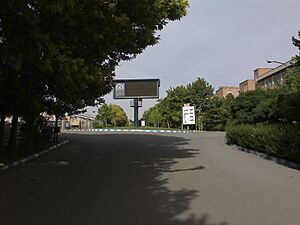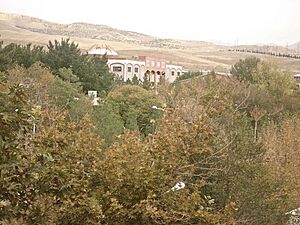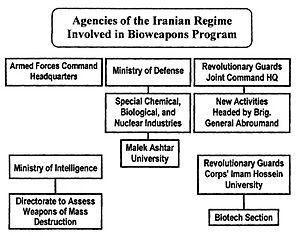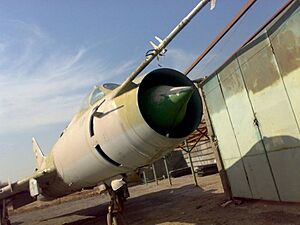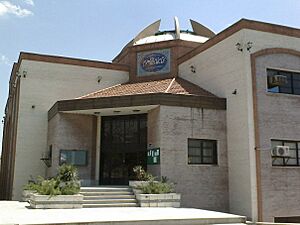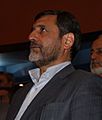Imam Hossein University facts for kids
|
دانشگاه امام حسین
Dāneshgāh-e Emām Hossein |
|
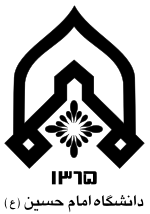
Imam Hossein University
coat of arms |
|
| Motto | تأمین نیروی انسانی متخصص |
|---|---|
|
Motto in English
|
Producing skilled manpower |
| Type | Public Military academy |
| Established | 1986 |
| Endowment | US$ 20.0 million (21 March 2013) |
| Chancellor | Mohammad-Reza Hassani Ahangar |
|
Academic staff
|
300 |
| Students | 6,000 |
| Undergraduates | 4,000 |
| Postgraduates | 2,000 |
| 500 | |
| Location |
,
35°45′02″N 51°35′15″E / 35.75056°N 51.58750°E |
| Campus | Urban |
| Colours | Green |
| Nickname | IHU |
| Affiliations | IRGC MSRT MODAFL |
The Imam Hossein Comprehensive University (also known as IHU) is a public university in Tehran, Iran. It opened in 1986. The university is connected to the Islamic Revolutionary Guard Corps (IRGC) and other government ministries.
IHU offers many study programs for both undergraduate and postgraduate students. About 6,000 students and cadets attend the university. The university is named after Husayn ibn Ali, an important figure in Islamic history.
Getting into IHU is a bit different from other universities. Regular students can join by passing the Iranian University Entrance Exam. These students pay tuition fees and are not guaranteed a job with the IRGC. However, some students receive scholarships from the IRGC. To get a scholarship, students must pass special interviews and medical tests. Being a member of Basij can also help them get a scholarship. These scholarship students have some rules, like not being allowed to work for private companies or travel abroad easily.
Contents
History of the University
The university was started in 1986 by Seyed Mehdi Mousavi Zare, a commander of the Islamic Revolutionary Guard Corps (IRGC). It was first called Imam Hossein Higher Education. The university was approved by Iran’s Ministry of Science, Research and Technology.
In 1987, it had different departments like engineering, natural science, social science, and medicine. Later, a department for military science was added. In 1994, the medical department became a separate university called Baqiyatallah Medical Sciences University. This medical university now trains students in nursing, health, and medicine.
How it Started
In 1963, Iran put all its military factories under one group called the Military Industries Organization (MIO). These factories made things like ammunition and explosives. They also put together helicopters and trucks from parts imported from other countries.
However, the Iran Revolution in 1979 stopped these activities. The MIO struggled without foreign experts. In 1981, the government created the Defense Industries Organization (DIO). By 1986, Iran was making many of its own weapons. To train people for these jobs, several universities were opened, including Imam Hossein University. These universities were linked to the DIO.
In 1989, the Ministry of Defense and the Guards joined together. The IRGC's facilities became part of the Defense Industry Organization. By the mid-1990s, they were working on Iran's rocket programs.
In June 2025, during a period of conflict, Imam Hossein University was affected by airstrikes. This caused damage to parts of the campus.
Research and Studies
Imam Hossein University has departments for science and nuclear physics. It is known for conducting experiments in nuclear research. Scientists in Iran use the university's labs for their studies.
The university also has a biological section. This part of the university studies microbes. Some experts believe that the university is a key place for Iran's advanced research programs. The British government and German government have noted the university's involvement in acquiring technology for advanced defense programs. In 2012, the U.S. Department of the Treasury added the university to a list that freezes its assets in the U.S. This was due to concerns about its research activities.
During the 1990s, Iran brought several nuclear research centers under one unit. They moved many nuclear facilities to the Defense Ministry and Imam Hossein University. The university has also worked on laser enrichment, a way to create nuclear fuel. They have also tested a neutron generator, which can start a chain reaction.
In 2006, the university held a conference about modern defense in chemical, biological, and nuclear areas. They discussed new types of bombs, like electromagnetic and laser bombs.
Physics Research Center
The university has a Physics Research Center (PHRC). This center is believed to be involved in Iran's nuclear program. Many nuclear experts from around the country have been moved to this university. The International Atomic Energy Agency (IAEA) has looked into how the IRGC might have used the university's research facilities.
For example, a company called Kimia Maadan (KM) Company used experts from this university. The IAEA had questions about this company. KM Company worked on a project to convert uranium oxide into a substance called Green Salt. This is an early step in the process of enriching uranium.
The IAEA has also reported on tests of high-explosive detonators and plans for an underground test facility at the university. In 2006, a U.S. official showed a diagram that looked like a nuclear test site in Iran. The IAEA also asked questions about the design of Iran's Shahab-3 missiles. These missiles are thought to be designed to carry advanced warheads.
The university's research groups, guided by the IRGC, have sought training and software for various advanced technologies. Iran has stated that some of this software was for studying things like aircraft collisions and car airbags.
Biological Research Center
Reports suggest that Iran's biological activities are focused on producing microbial substances. These activities are said to be carried out at Imam Hossein University. Genetic cloning is also done at Malek-Ashtar University of Technology. These claims were made in 2003.
Biological research began in 1985, during the Iran–Iraq War. A research center was set up at the Pasteur Institute of Iran to work on toxic fungi and microbes. As they succeeded in making large amounts of microbial material, the production centers moved to Imam Hossein University.
Experts from countries like China, North Korea, India, and Russia are working with Iran's Ministry of Defense. The Biological Research Center of Special Industries Organization is also involved. Students are given scholarships to study and use this technology. Other centers like Baqiyatallah Medical Sciences University and the Research Center for Direct Biotechnology also work on microbial studies.
Chemical Research Center
Imam Hossein University is involved in chemical technology and offers scholarships in this area. Since 1999, they have expanded their chemical research. One project involved building a fermentor. A group linked to the university produces a significant amount of nerve gas in different forms. Other chemicals like cyanide are also produced for various purposes.
Another organization run by the Defense Ministry is involved in producing chemical products. They have a chemical laboratory called Vira Laboratories and a storage facility. The Parchin Chemical Industries, near Tehran, is another center for chemical products. It has equipment to produce nerve gas.
A research center for chemical engineering in west of Tehran is used for joint studies by Imam Hossein University and Malek-Ashtar University of Technology. Chinese experts supervise some of these research projects.
Aerospace Research Center
Imam Hossein University offers degrees in Aerospace Engineering at both undergraduate and postgraduate levels. It is one of several universities in Iran that provide these degrees. Other universities include K. N. Toosi University of Technology, Sharif University of Technology, and Amirkabir University of Technology.
Iran started its scientific aerospace cooperation with China in 2000. In 2005, Iran signed an agreement with China to design and launch satellites. Since the 1990s, Iran has also worked on developing launch vehicles based on the Shahab-3 missile. In 2008, Iran developed a two-stage launch vehicle called Safir-1. In 2009, Iran launched a satellite named Omid into orbit using the Safir-2 launch vehicle. This made Iran the 9th nation to launch its own satellite. This achievement is notable because Iran has been under sanctions for many years.
Academic Life
Admissions
To get into Imam Hossein University for undergraduate studies, students must pass the Iranian University Entrance Exam, known as Konkour. This exam is given every year. Top students with high grades in high school are given priority. Also, students who rank high in the national entrance exam and choose Imam Hossein University as one of their top choices have a better chance.
University Rankings
| University rankings | |
|---|---|
| Global | |
| SIR World - Overall | 663 (2020) |
| SIR World - Research | 339 (2020) |
| SIR World - Innovation | 493 (2020) |
| National | |
| SIR National - Overall | 11 (2020) |
| SIR National - Research | 5 (2020) |
| SIR National - Innovation | 28 (2020) |
| ISC National - Overall | 11-15 (2018) |
| ISC National - Research | 30 (2018) |
| ISC National - Education | 9 (2018) |
| ISC National - Facilities | 1 (2018) |
Imam Hossein University is ranked among other universities in Iran. According to the Islamic World Science Citation Database (ISC) in 2018, it was ranked 30th for research and 9th for education in Iran. It was also ranked 1st for its facilities.
The SCImago Institutions Rankings (SIR) in 2020 placed Imam Hossein University at 663rd globally and 11th nationally among Iranian institutions. It also ranked 5th nationally for research and 28th for innovation.
Postgraduate Programs
Imam Hossein University offers many Master's and PhD programs. These programs are approved by the Ministry of Science, Research and Technology (Iran).
Master's Programs
- Logistics
- Strategic Information Intelligence
- Strategic Defense Studies
- Military Geography
- Cell and Molecular Biology Sciences
- Organic Chemistry
- Analytical Chemistry
- Physical Chemistry
- Inorganic Chemistry
- Nuclear Physics
- Electrical Engineering (Electronics)
- Mechanical Systems Engineering (Applied Design)
- Telecommunication Engineering (Coding Theory)
- Mechanical Engineering (Applied Design)
- Aerospace Engineering (Aerodynamics)
- Aerospace Engineering (Aircraft Structures)
- Spacecraft propulsion (Liquid-propellant rocket)
- Spacecraft propulsion (Solid-fuel rocket)
- Systems Sciences
- Atomic, Molecular, and Optical Physics
- Crisis Management
- Defense Management (Education)
- Defense Management (Human Resources)
- Defense Management (Logistics and Commerce)
- Defense Management (Finance and Accounting)
- Defense Management (Navy)
- Defense Management (Army)
- Defense Management (Special Force)
- Defense Management (Basij Force)
- Defense Management (Air Force)
- Civil Defense (Design)
- Civil Defense (Aircraft Structures)
- Civil Defense (Cooperative Cyber Defense)
PhD Programs
- Aerospace Mechanical Engineering (Applied Design)
- Industrial Engineering (Systems Engineering Research)
- Molecular Biotechnology
- Laser Physics
- Applied Mathematics (Coding Theory)
- Sociometry
- Crisis Management
- Military Intelligence
- Security Intelligence
Publications
Imam Hossein University publishes several journals and books. Some of these include:
- IHU Journal of Fluid Mechanics and Aerodynamics
- IHU Journal of Radar
- IHU Journal of Electromagnetism
- IHU Journal of Mechanics and Aerospace
- IHU Journal of Electronic Defense and Cyber
- IHU Journal of Civil Defense
- IHU Journal of Science and Culture
- IHU Journal of Defense Policy
- IHU Journal of Military Geography
University Structure
Faculties
When it first started, Imam Hossein University had four main faculties (or departments):
- Faculty of Engineering Science, with departments like Mechanical Engineering, Civil Engineering, and Aerospace Engineering.
- Faculty of Natural Science, which included Physics, Chemistry, and Biology.
- Faculty of Social Science (started in 1987), with departments like Management and Economics.
- Faculty of Medicine (started in 1987).
Later, in 1990, a Faculty of Military Science was added. In 1994, the Faculty of Medicine became its own university.
Facilities
The main buildings of the university are located in Tehran. They include:
- Departments for Mechanical, Electrical, Computer, Chemistry, and Physics Engineering.
- A Department of Military Science.
- A Central Library.
- A Publication Office.
- A Restaurant.
Associated Institutes
The university works with several research institutes. These include:
- Physics Research Center (PHRC)
- Biological Research Center
- Chemical Research Center
- Aerospace Research Center
- Education Research Institute (ERI)
- Institute of Applied Physics (IAP)
The university also cooperates with other organizations linked to the IRGC and Defense Industries Organization. Some of these are:
- Baqiyatallah Medical Sciences University
- Malek-Ashtar University of Technology
- Centers for Science and Technological Growth
- Biological Research Center of Malek Ashtar University
- Research Center for Direct Biotechnology
- Sina Industry (Vira Laboratories)
- Shahid Hemmat Industrial Group (SHIG)
- Parchin Site
- Lavizan II Site
- Sanam College
- Tehran's Gostaresh Research Center
- Ya Makhdi industrial complex
- Pasteur Institute of Iran
- Aerospace Industries Organization (AIO)
- Shahid Meisami Complex
- Ore Processing Center (OPC)
- Biological Research Center of SIO
- Sanam Industrial Group/Aerospace Industries Organization (AIO)
- Damghan's Weapons Industry
- Kimia Maadan (KM) Company
- Baltic State Technical University (until 1998)
- China Aerospace Science and Technology Corporation
- National Center for Genetic Engineering and Biotechnology Research
- The Institute of Biochemistry and Biophysics (IBB)
- Tehran's Biochemical and Bioenvironmental Research Center
- Group of Fermentation and Biological Technology
- Shahid Khassan Bagheri Industrial-factory Program (SHBIFG)
- Shahid Bagheri Industrial Group (SBIG)
- Instrumentation Factories Plant (IFP)
- Shahid Shafizadem Industrial Complex
- Missile Industrial Group at Parchin
- Shahid Babaye Industrial Complex (SBIC)
- Mechanical Systems Industrial Group (MIG)
- Special Industrial Groups of the Ministry of Defense (MIDSPCIG)
Notable People from IHU
Many important people have studied or taught at Imam Hossein University. Some of them include:
- Fereydoon Abbasi, a physics professor and former head of the Atomic Energy Organization of Iran.
- Mohsen Fakhrizadeh, a nuclear physics professor and former head of the Physics Research Center at the university.
- Masoud Alimohammadi, a particle physics professor.
- Majid Shahriari, a nuclear engineer and professor.
- Mohsen Rezaee, one of the university's co-founders and a lecturer.
- Mostafa Ahmadi-Roshan, a nuclear physicist and professor.
- Parviz Fattah, a politician and former minister, who earned a master's degree from IHU.
- Masoud Mir Kazemi, a politician and former minister, also a lecturer at IHU.
- Mohammad Soleimani, a former minister and professor.
- Mohammad Ardakani, a former minister and professor.
- Mehdi Isazadeh, a politician who earned a master's degree in defense management from IHU.
- Hossein Saffar Harandi, a former minister.
-
Mohsen Fakhrizadeh, a nuclear physics professor at Imam Hussein University, and former head of the Physics Research Center.
Leaders of Imam Hossein University
Here are the chancellors (leaders) of Imam Hossein University since it was founded:
- Mahdi Mousavi Zare (1984-1985)
- Masoud Hajjarian (1985-1989)
- Mohammad Ebrahim Sanjaghi (1989)
- Ali Hosseini-Tash (1989-1994)
- Alireza Andalib (1994-1998)
- Alireza Afshar (1998-2000)
- Ahmad Fazaeli (2000-2005)
- Ali Akbar Ahmadian (2005–2007)
- Reza Karami-Nia (2007)
- Ali Hosseini-Tash (2007-2009)
- Hossein Zarif-Manesh (2009–2013)
- Mohammad-Reza Hassani Ahangar (2013–Present)
See also
- List of universities in Iran
- Baqiyatallah Medical Sciences University
- Iranian Space Agency
- Defense Industries Organization
- Iran Electronics Industries
- Iran Aviation Industries Organization
- Nuclear program of Iran
Images for kids


